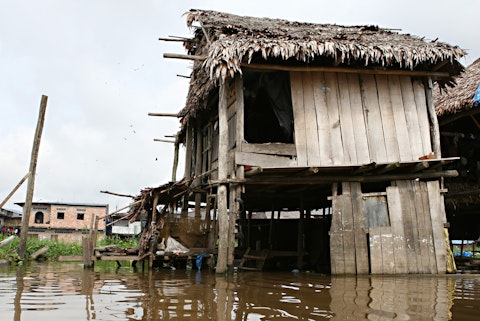In this article, we’ll list countries that will be the most underdeveloped heading into 2024. If you want to skip our overview of the regions where poverty and underdevelopment prevail, read 10 Least Developed Countries in the World Heading into 2024.
As we approach 2024, several factors continue to hinder development in some world regions. The United Nations reports that over 80% of the world’s extreme poor reside in rural areas, with poverty rates almost three times higher than in urban areas. The global food insecurity crisis has exacerbated this issue, with about 29.6% of the global population (2.4 billion people) experiencing moderate or severe food insecurity in 2022, a notable increase from 2019. Consequently, eradicating poverty and hunger remains a crucial goal, particularly in the least developed countries, home to more than half of the world’s extreme poor. These countries suffer from high levels of food insecurity and malnutrition, worsened by pre-existing vulnerabilities.
Furthermore, the world faces an inequality crisis. According to the UN, 46 countries, representing 14% of the global population, encounter substantial obstacles to economic progress, including limited access to technology, finance, and opportunities. As a result, underdeveloped countries struggle with plummeting GDP growth, high debt levels, and a lack of economic diversification. The global financial system often exacerbates these issues by imposing unsustainable external debt burdens on these countries, resulting in only a few countries climbing the economic ladder.
Weak governance, conflict, health crises, and unfair international trade practices also play a role in countries’ regression to underdevelopment. The international community’s commitment to multilateralism and depoliticizing technological and financial issues is vital for the development of these struggling economies. Addressing extreme poverty and fostering socio-economic development requires efforts to reduce intergenerational inequalities that further impede the progress of underdeveloped countries.
Check which countries’ status might change as we head into 2024 by reading Top 20 Most Underdeveloped Countries In The World In 2023.
Corporations’ Role in Low-Income Countries
Recent events have highlighted the frictional dynamics between some corporations and some underdeveloped countries. For instance, a conflict at the Tenke Fungurume copper mine in the Democratic Republic of Congo, operated by China’s CMOC Group Limited, led to export bans impacting the global supply chain of copper and cobalt from 2022 to 2023. To resolve this, CMOC Group Limited agreed to pay $800 million to its DRC partner, Gecamines, and committed to $1.2 billion in dividends, addressing concerns about the copper and cobalt supply.
Similarly, Botswana, the world’s second-largest diamond producer, is considering reducing its reliance on its UK partner — De Beers — a subsidiary of Anglo American Plc. Presently, Anglo American secures 75% of diamonds from Debswana, Botswana’s largest diamond company, while the state-owned Okavango Diamond Company owns the remaining 25%. Botswana’s president advocates selling more diamonds through alternative channels, aiming to enhance the country’s diamond production independence and economic growth.
Also Read: Top 20 Diamond Producing Countries in the World
In contrast, some corporate initiatives in low-income countries are geared towards empowering local communities. A prime example is Alphabet Inc.’s (NASDAQ:GOOG) Google Africa project, which focuses on improving access to information and technology across Africa. This Alphabet Inc (NASDAQ:GOOG) initiative aims to provide digital skills training to individuals and businesses, enhancing their technical capabilities. Alphabet Inc (NASDAQ:GOOG) has committed $1 billion over five years to foster innovation in economically challenged African countries, aiming to boost digital literacy and local employability.
Another company actively contributing to Africa’s economy is Ford Motor Company (NSE:F). Expanding its presence beyond South Africa, Ford Motor Company (NSE:F) established a production facility in Lagos State, Nigeria, in 2017. This move strengthened Ford Motor Company (NSE:F)’s position in two of Africa’s largest economies and brought economic benefits to the region, including creating approximately 180 local jobs and achieving a production capacity of 5,000 units annually.
Let’s now move toward poverty-stricken countries and their challenges!
Also Read: 32 Landlocked Developing Countries

40 Least Developed Countries in the World Heading into 2024
Our Methodology
We shortlisted the least developed countries in the world heading into 2024 by considering their Human Development Index (HDI) scores and GDP per capita. The Human Development Index (HDI) is a statistical tool used to measure a country’s overall achievement in its social and economic dimensions. Initially, we selected the countries with the lowest rankings (191 being the lowest score) in the latest Human Development Index, followed by identifying their GDP per capita. Subsequently, we averaged the rankings of these two metrics to compile our final list, arranging the countries in descending order based on their results. Moreover, to better explain these countries’ struggles with resource allocation needed for development, we referred to the World Bank’s dataset on countries with the highest rates of poverty for their poverty rates that we have mentioned for some countries in our current list.
Based on our findings, here are the least developed countries heading into 2024:
40. Republic of Congo
HDI Ranking: 153
GDP Per Capita: $2448
Composite Score: 40
In 2023, the Republic of Congo faces significant economic challenges marked by pressing socio-economic issues. The country contends with a high poverty rate, as over 34% of its population lives on less than $2.15 a day. Furthermore, food insecurity is a critical concern, affecting approximately 56% of Congolese people. The World Bank highlights that the government’s reliance on fuel subsidies, primarily benefiting wealthier urban dwellers, burdens public finances. This reliance diverts funds from essential investments in areas such as infrastructure, education, health, and social services.
39. Papua New Guinea
HDI Ranking: 156
GDP Per Capita: $3020
Composite Score: 39
Papua New Guinea has experienced a robust economic recovery following COVID-19 but faces challenges. The economy, buoyed by high commodity prices and relaxed pandemic restrictions, is addressing a narrowing fiscal deficit. However, economic growth is expected to slow due to decreased global demand and supply constraints. Another key concern is the substantial gender inequality highlighted by the World Bank. Addressing the disparity in employment between men and women and combating gender-based violence, which incurs significant economic and social costs, is crucial for sustainable growth.
Also Read:30 Hungriest Countries in the World
38. Kenya
HDI Ranking: 152
GDP Per Capita: 2099
Composite Score: 38
Kenya’s economy faces vulnerabilities, including inflationary pressures, currency fluctuations, and a concerning impact on food security due to drought. Despite an average annual GDP growth of around 4.8%, the country’s economic outlook is at risk due to spending pressures and a potential slowdown in tax collection efforts. Currently, approximately 29.4% of Kenyans live in extreme poverty, grappling with challenges such as unemployment, illiteracy, and a high disease burden.
37. Solomon Islands
HDI Ranking: 155
GDP Per Capita: $2203
Composite Score: 37
The Solomon Islands’ economy is recovering from the impacts of civil unrest and COVID-19, yet remains fragile. The country faces challenges such as a decline in its terms of trade and rising inflation, partly due to global events like the war in Ukraine. The International Monetary Fund (IMF) notes a weakening in the country’s external position, exacerbated by declining log exports and a substantial pipeline of infrastructure projects financed through concessional borrowing.
36. Côte d’Ivoire (Ivory Coast)
HDI Ranking: 159
GDP Per Capita: $2486
Composite Score: 36
Côte d’Ivoire, a leading producer of cocoa and cashew nuts, faces multiple challenges. The country has sustained robust economic activity and growth rates; however, rising import prices, global monetary tightening, and regional political instability pose threats. Inflation in Ivory Coast has reached its highest level in a decade, driven by increasing food, transport, and energy costs. Positively, the government’s implementation of the National Development Plan, along with the World Bank’s Country Partnership Framework, aims to accelerate economic transformation and improve human capital.
Find which other countries lead in cocoa production in the Top 20 Cocoa Producing Countries in the World.
35. Mauritania
HDI Ranking: 158
GDP Per Capita: $2190
Composite Score: 35
Mauritania is grappling with significant economic challenges, largely attributable to climate change, which has led to recurrent droughts and floods. These natural disasters, exacerbated by unplanned urban expansion and inadequate drainage systems, have severely impacted the population and obstructed sustainable growth. Although the economy is growing, evidenced by increased exports and consumer spending, high inflation rates have offset gains in per capita GDP and impeded poverty reduction efforts.
34. Zambia
HDI Ranking: 154
GDP Per Capita: $1487
Composite Score: 34
In Zambia, 61.6% of the population survives on less than $2.15 a day, a situation attributed to the country’s limited economic diversification. The economic recovery faces challenges in key sectors such as agriculture, mining, and construction. Although there are efforts to strengthen the recovery, high inflation and currency depreciation have limited their effectiveness.
33. Comoros
HDI Ranking: 156
GDP Per Capita: $1484
Composite Score: 33
Comoros, with its limited arable land, frequently faces natural disasters, leading to severe hunger and poverty. While the country aspires to become a middle-income country by 2050, achieving this goal will necessitate major economic reforms and investments in key sectors. Currently, the country’s growth model has not yielded high growth or significant long-term poverty reduction. There is also an urgent need for Comoros to develop sectors like tourism and fisheries to create jobs and alleviate poverty.
32. Nigeria
HDI Ranking: 163
GDP Per Capita: $2184
Composite Score: 32
Despite having the strongest GDP in Sub-Saharan Africa, Nigeria remains one of the least developed countries heading into 2024. Its economic challenges are characterized by long-standing macroeconomic imbalances and the urgent need for policy reforms. To achieve sustainable and inclusive growth, Nigeria must implement targeted cash transfers to protect the poor from rising living costs. Additionally, adopting a comprehensive reform approach is crucial to break the cycle of low growth and high poverty, as recommended by the World Bank.
31. Pakistan
HDI Ranking: 161
GDP Per Capita: $1596
Composite Score: 31
Pakistan is among the struggling economies heading into 2024 due to a high level of debt, reliance on foreign loans, and a narrow tax base. This situation limits the government’s ability to invest in critical areas such as education, health, and infrastructure, further straining the economy. Additionally, Pakistan faces compounded challenges due to annual devastating floods, increased global commodity prices, and inconsistent policy responses. With the poverty rate in the lower middle-income bracket expected to rise, the urgency for economic reforms is highlighted.
30. Haiti
HDI Ranking: 163
GDP Per Capita: $1748
Composite Score: 30
Haiti’s economic and social development is severely hindered by political instability, escalating violence, and high levels of insecurity. These factors contribute to its status as the poorest country in the Latin America and Caribbean region and one of the poorest globally. Its current GDP per capita stands at $1,748, accompanied by a high GINI index, indicating significant income inequality. Moreover, natural disasters, such as the 2021 earthquake, have caused substantial human and infrastructural losses, further impeding Haiti’s development.
29. Djibouti
HDI Ranking: 171
GDP Per Capita: $3136
Composite Score: 29
Djibouti’s economic growth has decelerated due to global challenges such as inflation, severe drought, and reduced demand for its ports, particularly from Ethiopia. The country is experiencing heightened inflation, driven by high global oil and food prices, with the year-on-year rate reaching 11% by mid-2022. Additionally, fiscal deficits have widened due to measures against global crises and rising public debt service costs, resulting in a temporary suspension of some foreign debt payments.
28. Tanzania
HDI Ranking: 160
GDP Per Capita: $1192
Composite Score: 28
In Tanzania, over 44% of the population lives in extreme poverty, regularly facing challenges like food insecurity and unemployment. While the country has improved its tax collection to bolster its economic position, further enhancement of domestic revenue mobilization is needed. The World Bank has also observed that public spending in Tanzania remains below the average for lower-middle-income countries, with noticeable gaps in social spending.
27. Senegal
HDI Ranking: 170
GDP Per Capita: $1598
Composite Score: 27
Senegal’s economic growth slowed in 2022 amid strong inflationary pressures and a global economic downturn. Currently, around 39% of the country’s population lives in extreme poverty, with limited or no access to positive monetary prospects.
26. Benin
HDI Ranking: 166
GDP Per Capita: $1303
Composite Score: 26
In Benin, the demographic and economic landscape is characterized by high fertility rates, low life expectancy, and a substantial portion of the labor force engaged in informal employment. The poverty rate stood at 38.5% in 2019, and the country ranks low on the Human Development Index. Benin’s economy, heavily reliant on exporting unprocessed agricultural products and re-exporting imported goods, is vulnerable to external shocks and struggles with high public debt.
25. Togo
HDI Ranking: 162
GDP Per Capita: $918
Composite Score: 25
Togo’s economy, which has been impacted by multiple shocks since 2020, is projected to grow at around 5.2% in 2024, with the potential to reach 5.8% in 2025. This growth hinges on trade openness and increased private investment. However, despite the positive outlook, Togo’s current economic status positions it among the least developed countries in the world heading into 2024.
24. Lesotho
HDI Ranking: 168
GDP Per Capita: $1107
Composite Score: 24
Lesotho’s growth is hindered by corruption vulnerabilities and limited financial access. The economy faces challenges due to a large public sector that distorts economic incentives and inhibits private investment. Additionally, Lesotho’s landlocked status further limits its trade opportunities and exacerbates poverty among its population.
23. Rwanda
HDI Ranking: 165
GDP Per Capita: $966
Composite Score: 23
In Rwanda, where over 52% of the population lives in severe poverty, the country ranks among the hungriest and least developed countries in the world. Although Foreign Direct Investment (FDI) has been vital for job creation and social security, there is a need for policies that make FDI more inclusive, with a focus on women, youth, and poorer districts.
22. Uganda
HDI Ranking: 166
GDP Per Capita: $964
Composite Score: 22
Uganda, with one of the highest population growth rates globally, faces strain on its weak economy. The country’s poverty rate is projected to decrease from 41.7% in 2023 to 40.7% by 2025. However, for sustainable progress, its growth model, which currently relies on debt-financed public spending, needs to shift focus toward human capital development and the adoption of digital technology.
Also Read: 50 Most Populated Countries in 2050
21. Sudan
HDI Ranking: 172
GDP Per Capita: $1102
Composite Score: 21
Sudan’s substantial internal conflict has weakened its role as a regional leader. The secession of South Sudan in 2011 resulted in major economic shocks, notably the loss of significant oil revenue. Additionally, Sudan hosts a large number of refugees and internally displaced persons, which adds to its social and economic strains. The country’s recent political instability, marked by a military takeover and ongoing conflicts, has exacerbated its humanitarian crisis and economic challenges.
20. Guinea
HDI Ranking: 182
GDP Per Capita: $1513
Composite Score: 20
Guinea’s economy, heavily reliant on agriculture and natural resources, faces challenges in governance and environmental impact management. These issues have been aggravated by political instability following the 2021 coup d’état. The country also contends with fiscal problems, such as low tax revenues and public debt management, with political uncertainties impeding necessary economic reforms.
19. Ethiopia
HDI Ranking: 175
GDP Per Capita: $1027
Composite Score: 19
Ethiopia, known for its robust growth rates and effective management of government deficits, is facing global economic challenges, including inflationary pressures and declining government revenue. The country’s current GDP stands at $156.03 billion, with approximately 27% of its population living in adversity. This situation results in most of the country’s financial spending being allocated to basic necessities.
18. Gambia
HDI Ranking: 174
GDP Per Capita: $840
Composite Score: 18
In Gambia, economic growth is resilient but constrained by structural limitations such as rising commodity prices and sluggish growth in the tourism sector. High inflation and persistent poverty remain significant challenges, with over 48% of Gambians living in poverty.
17. Malawi
HDI Ranking: 169
GDP Per Capita: $645
Composite Score: 17
Malawi’s progress toward long-term development is hampered by macro-fiscal crises, debt challenges, and sluggish governance reforms. Natural disasters and foreign exchange shortages further weaken the country’s economy. Additionally, over 50% of Malawi’s population lives in poverty and faces developmental obstacles, including corruption, which impact its $17 billion economy.
16. Guinea-Bissau
HDI Ranking: 177
GDP Per Capita: $775
Composite Score: 16
Guinea-Bissau is facing an economic downturn characterized by rising inflation and increasing budget deficits. The country struggles to attract private finance for climate mitigation and adaptation, hindered by gaps in regulation and expertise. These challenges impede progress in critical sectors such as energy and agriculture. Furthermore, a 2010 survey by the International Fund for Agricultural Development (IFAD) revealed that 69.3% of Guinea-Bissau’s population lives in poverty, with 33% experiencing extreme poverty.
15. Eritrea
HDI Ranking: 176
GDP Per Capita: $643
Composite Score: 15
Eritrea’s economic challenges stem largely from its dependence on wheat and oil imports from Russia and Ukraine, making it vulnerable to global crises such as the Russia-Ukraine conflict. Additionally, the country’s economy faces pressure from climate-related issues and regional conflicts. A major concern is the prevalent poverty, with a significant part of the workforce earning only minimum wages.
14. Madagascar
HDI Ranking: 173
GDP Per Capita: $505
Composite Score: 14
In Madagascar, economic growth is hindered by frequent natural disasters and a predominantly unskilled workforce, a consequence of the country’s inadequate education system. Although the government’s attempts to combat inflation have resulted in increased spending and a larger budget deficit, poverty continues to be a significant concern.
13. Burkina Faso
HDI Ranking: 184
GDP Per Capita: $832
Composite Score: 13
Burkina Faso’s economic downturn is attributed to security challenges leading to mine closures and political instability. This impacts significantly as a large portion of the population was employed in the mining sector. Furthermore, while there has been growth in agriculture and services, high inflation and reduced public investment are restricting the country’s development.
12. South Sudan
HDI Ranking: 191
GDP Per Capita: $1071
Composite Score: 12
South Sudan has the world’s highest poverty rate, with approximately 76.4% of its population living on less than $2.15 a day. South Sudan’s secession from Sudan hasn’t helped the country’s economic standing either and its also one of the most dangerous countries in the world.
11. Liberia
HDI Ranking: 178
GDP Per Capita: $545
Composite Score: 11
Liberia’s economic growth, primarily fueled by sectors such as mining and construction, has decelerated, leading to an expanding fiscal deficit. Although inflation has decreased somewhat, it remains a significant issue, with over 27% of the population living on less than $2.15 a day.
Click to continue reading 10 Least Developed Countries in the World Heading into 2024.
Suggested Articles:
- 30 Least Developed Countries in the World and Funds that Invest in Them
- 50 Most Populated Countries in 2030
- 30 Heavily Indebted Poor Countries
Disclosure: None. 40 Least Developed Countries in the World Heading into 2024 was originally published at Insider Monkey.




